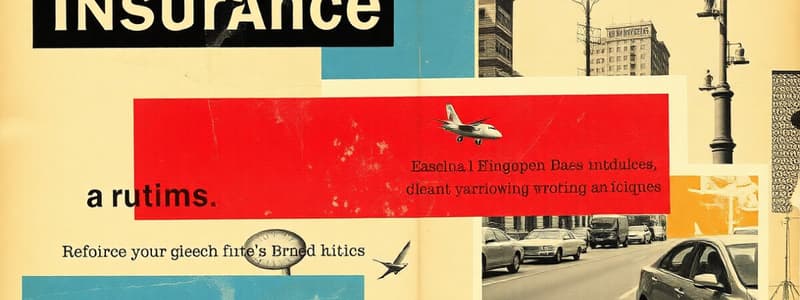Podcast
Questions and Answers
What happens to the policy if total debt becomes higher than the Cash Surrender Value?
What happens to the policy if total debt becomes higher than the Cash Surrender Value?
- The policy can be reinstated without conditions.
- The policy is automatically renewed.
- The policy will automatically terminate. (correct)
- The policy will remain active with all benefits.
What is the grace period for premium payments before a policy lapses?
What is the grace period for premium payments before a policy lapses?
- 90 days
- 15 days
- 31 days (correct)
- 60 days
Which condition allows for the reinstatement of a lapsed policy?
Which condition allows for the reinstatement of a lapsed policy?
- The policy must be surrendered for Cash Surrender Value.
- The insured must not be insurable according to company rules.
- No debts related to the policy are allowed.
- All back premiums must be paid with interest. (correct)
What benefit ends if the policy lapses due to non-payment of premiums?
What benefit ends if the policy lapses due to non-payment of premiums?
Under what circumstances will a reinstated policy cover events?
Under what circumstances will a reinstated policy cover events?
What is the maximum personal accident benefit for individuals aged 18-65?
What is the maximum personal accident benefit for individuals aged 18-65?
What is the waiting period for the Enhanced Waiver of Premium (EWP) rider benefit to take effect?
What is the waiting period for the Enhanced Waiver of Premium (EWP) rider benefit to take effect?
Which payment terms are available for the Base Plan?
Which payment terms are available for the Base Plan?
What happens to the premiums in the event of Total and Permanent Disability under the Enhanced Waiver of Premium?
What happens to the premiums in the event of Total and Permanent Disability under the Enhanced Waiver of Premium?
What type of cash surrender value is associated with the riders?
What type of cash surrender value is associated with the riders?
Which age group is eligible for the Enhanced Waiver of Premium rider benefit?
Which age group is eligible for the Enhanced Waiver of Premium rider benefit?
What is the purpose of the Payor’s Benefit on Death and Disability (PBDD) rider?
What is the purpose of the Payor’s Benefit on Death and Disability (PBDD) rider?
Is the Vitality Integration applicable to the rider benefits?
Is the Vitality Integration applicable to the rider benefits?
What is the latest age up to which an individual can be insured under the base plan?
What is the latest age up to which an individual can be insured under the base plan?
Which payment term allows the insured to pay for the longest duration?
Which payment term allows the insured to pay for the longest duration?
What is the maximum face amount available under the insurance plan?
What is the maximum face amount available under the insurance plan?
Which of the following occupations are exempt from obtaining the Total and Permanent Disability (TPD) rider?
Which of the following occupations are exempt from obtaining the Total and Permanent Disability (TPD) rider?
What type of premium structure is followed by the insurance plan?
What type of premium structure is followed by the insurance plan?
What is the premium payment period in relation to the basic plan?
What is the premium payment period in relation to the basic plan?
What benefit does the insurance plan not provide?
What benefit does the insurance plan not provide?
Which statement regarding Vitality Integrated plans is correct?
Which statement regarding Vitality Integrated plans is correct?
What is the death benefit payable for any event except suicide whilst sane?
What is the death benefit payable for any event except suicide whilst sane?
What happens to the Payor’s Term Benefit rider if the payor dies from suicide within 2 years of the effective date?
What happens to the Payor’s Term Benefit rider if the payor dies from suicide within 2 years of the effective date?
What defines total and permanent disability for claims?
What defines total and permanent disability for claims?
What must happen after a claim for a total and permanent disability benefit is approved?
What must happen after a claim for a total and permanent disability benefit is approved?
If a payor dies by suicide whilst sane, what is the benefit payable?
If a payor dies by suicide whilst sane, what is the benefit payable?
Which of the following is true regarding the policy status after claims under the death benefit?
Which of the following is true regarding the policy status after claims under the death benefit?
What is required for an insured to qualify for total and permanent disability benefits?
What is required for an insured to qualify for total and permanent disability benefits?
What occurs to the death benefit when the payor has outstanding debt to the company?
What occurs to the death benefit when the payor has outstanding debt to the company?
What is the primary purpose of the grace period in insurance policies?
What is the primary purpose of the grace period in insurance policies?
Which of these best describes non-forfeiture options?
Which of these best describes non-forfeiture options?
In the context of insurance, what does the underwriting approach primarily focus on?
In the context of insurance, what does the underwriting approach primarily focus on?
What is a critical feature of policy loans in insurance?
What is a critical feature of policy loans in insurance?
Which of the following best describes the free-look period?
Which of the following best describes the free-look period?
What does lapsation refer to in insurance?
What does lapsation refer to in insurance?
What information is critical in an application form for insurance?
What information is critical in an application form for insurance?
What is renewability in insurance policies primarily concerned with?
What is renewability in insurance policies primarily concerned with?
Which statement is true regarding contractual policy changes?
Which statement is true regarding contractual policy changes?
What do dividend options in an insurance policy usually provide?
What do dividend options in an insurance policy usually provide?
Study Notes
Premium and Payments
- Premium and Payments:
- Currency: The text does not specify what currency is used.
- Pay Period: The pay period is not specified in the text.
- Minimum Premium: P 100,000
- Maximum Premium: P 75,000,000
- Mode of Payment: Not specified.
- Method of Payment: Not specified.
- Policy Fee: Not specified.
- Grace Period: 31 Days
New Business, Underwriting, and Processing Guidelines
- Application form: Standard application form is used.
- Sales Illustration: A sales illustration is provided.
- Underwriting Approach and Guidelines:
- Underwriting Net Amount at Risk: The text does not provide details on underwriting net amount at risk.
- Medical and Occupational Ratings: The text does not provide specific medical and occupational ratings.
- Free-Look Period: The period is not specified in the text.
Policy Owner Services
- Non-Forfeiture Options: Not specified in the text.
- Dividend Options: Not specified.
- Policy Loans:
- If the total debt exceeds the Cash Value, the policy will lapse.
- Policy will terminate if the balance exceeds the Cash Surrender Value.
- Renewability: Not applicable.
- Convertibility: Not applicable.
- Lapsation:
- If premiums are not paid by the end of the grace period, the policy will lapse.
- All benefits, except those under the Non-Forfeiture Option, will end.
- Reinstatement:
- The policy can be reinstated within 3 years from the date of lapse.
- The policy must not have been surrendered for Cash Surrender Value.
- The insured must be insurable according to company rules.
- All back premiums must be paid with interest, or any debt must be paid or resumed.
- Any reinstated policy will only cover events occurring after the reinstatement date, subject to the contestability of the policy.
Issue Age and Coverage
- Base Plan Coverage Period: Up to age 65
- Payment Terms:
- 5 years to pay
- 10 years to pay
- Insured Issue Age: 18-45
- Rider Benefit Term: Up to policy maturity or age 65 of the insured, whichever comes first.
Occupations Exempted from Total and Permanent Disability (TPD) Rider
- Allotee, Homemaker
- Minor
- Pensioner, Retiree
- Student (not aviation, marine, or military)
- New Graduate
Riders
-
All Personal Accident (PA) Benefits Per Life
- Issue Age: 18-65
- Maximum Benefit: ₱ 50,000,000
- Premium Structure: Level premium (will follow the pay-period of the Basic Plan).
- Rider Cash Surrender Value: None.
- Vitality Integration: Applicable if Base Plan is vitality integrated.
-
Enhanced Waiver of Premium (EWP)
- Waives both base and rider premiums in case of TPD or diagnosis of any covered Critical Illness (CI).
- Issue Age: 18-45
- Payment Terms:
- 5 years to pay
- 10 years to pay
- Premium Structure: Level premium (will follow the pay-period of the Basic Plan).
- Rider Cash Surrender Value: None.
- Vitality Integration: Not applicable.
- Waiting period: 90 days from policy effective date.
-
Payor's Benefit on Death and Disability (PBDD)
- Waives the total premium (Base and rider) in case of death or TPD of the Payor/Policy Owner.
- Policy will terminate if total debt becomes higher than the Cash Surrender Value.
- Renewability: Not applicable.
- Convertibility: Not applicable.
- Lapsation:
- If premiums are not paid by the end of the grace period, the policy will lapse.
- All benefits, except those under the Non-Forfeiture Option, will end.
Benefits Payable
-
Death of the Payor/Policy Owner
- Any event except suicide while sane: Death Benefit = Payor's Term Benefit (PTB) Face Amount less any debt to the company.
- Suicide while sane within 2 years from the effective date: Death Benefit = Payor's Term Benefit (PTB) Premium less any debt to the company.
-
Total and Permanent Disability (TPD) Claims
- Insured gets TPD due to bodily injury or disease and cannot perform 3 or more activities from the 6 Activities of Daily Living: TPD Benefit = 100% of the TPD Face Amount.
Studying That Suits You
Use AI to generate personalized quizzes and flashcards to suit your learning preferences.
Related Documents
Description
This quiz covers essential topics related to insurance premiums, payment methods, and underwriting guidelines. It explores minimum and maximum premium amounts, grace periods, application forms, and policy owner services. Test your understanding of the key elements in these insurance processes.




